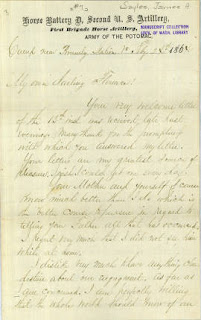 |
| This is the first scene in "Lincoln" when two Union soldiers are speaking with Lincoln. |
a. Lincoln was uncompromising in that he would not differ in his opinion toward the 13th Amendment. Thaddeus Stevens was uncompromising in that he strongly upheld the belief that all people are created equal no matter their race. Both of these men upheld similar ideals but Thaddeus Stevens was more radical and forthcoming about his ideals.
2. To what extent did the movie provide evidence of Lincoln's perspective as depicted in the Lincoln letters?
a. The movie showed Lincoln's perspective when he was talking with the typer that was typing up his letter in order to send off to General Ulysses S. Grant. Lincoln shared his own personal opinions and even ended up revising the letter as he went along with the boy.
3. Why did Lincoln believe the 13th Amendment was essential?
a. Lincoln believed that the 13th Amendment was essential in order to finally discourage slavery more so than the Emancipation Proclamation, and to keep the Union together after the war.
4. How did the film complicate the narrative that the North was against slavery and/or for racial equality, while the South was for slavery and against racial equality?
a. I feel that the narrative was already very complicated in that you see the fight between Lincoln trying to gain followers and voters to pass his Amendment and on the opposing side you can see the southern States fighting to keep slavery because they know what this Amendment will bring.
5. For what reasons did people seem to resist the ending of slavery? Did the film depict this as a matter of concern for property rights, or something else?
a. Many of the characters in the movie are fighting for equality while there still are many that are fighting to keep the slaves rights below the slave owners rights. I feel that fighting for white supremacy is more of a Human Rights concern than a property rights.












